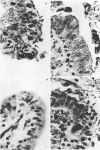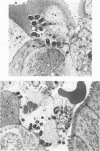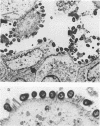Abstract
Hafnia alvei, a member of the family Enterobacteriaceae, was the only species of bacteria cultured from the stool of a 9-month-old child who was admitted with a 3-day history of watery diarrhea. The isolated strain of H. alvei failed to produce heat-labile or heat-stable enterotoxins or Shiga-like toxin I or II and did not invade HeLa cells, nor did it cause keratoconjunctivitis (determined by the Sereny test) in a guinea pig's eye. The strain, however, induced diarrhea in 8 of 12 adult rabbits with removable intestinal ties (removable intestinal tie-adult rabbit diarrhea [RITARD] assay) and in 1 of 2 orally fed animals. No diarrhea could be induced with Escherichia coli K-12 in eight RITARD assay rabbits and three orally fed rabbits, respectively. Microscopic examination of affected animals revealed moderate inflammatory cellular infiltration of the intestinal mucosa, in which bacterial attachment to the surface epithelium and loss of the microvillus border were evident in the ileum and colon. Electron microscopy demonstrated cellular modifications of the apical surface, with cupping or pedestal formation and increased terminal web density at sites of bacterial "attachment-effacement," a well-known characteristic and mechanism of diarrhea of enteropathogenic E. coli. Identical lesions were also induced by H. alvei in rabbit ileal loops, which ruled out naturally occurring rabbit enteropathogenic E. coli strains, which are known to produce similar lesions. It is concluded that at least some strains of H. alvei have the potential to cause diarrhea and that attachment-effacement is a virulence characteristic shared by bacteria other than E. coli.
Full text
PDF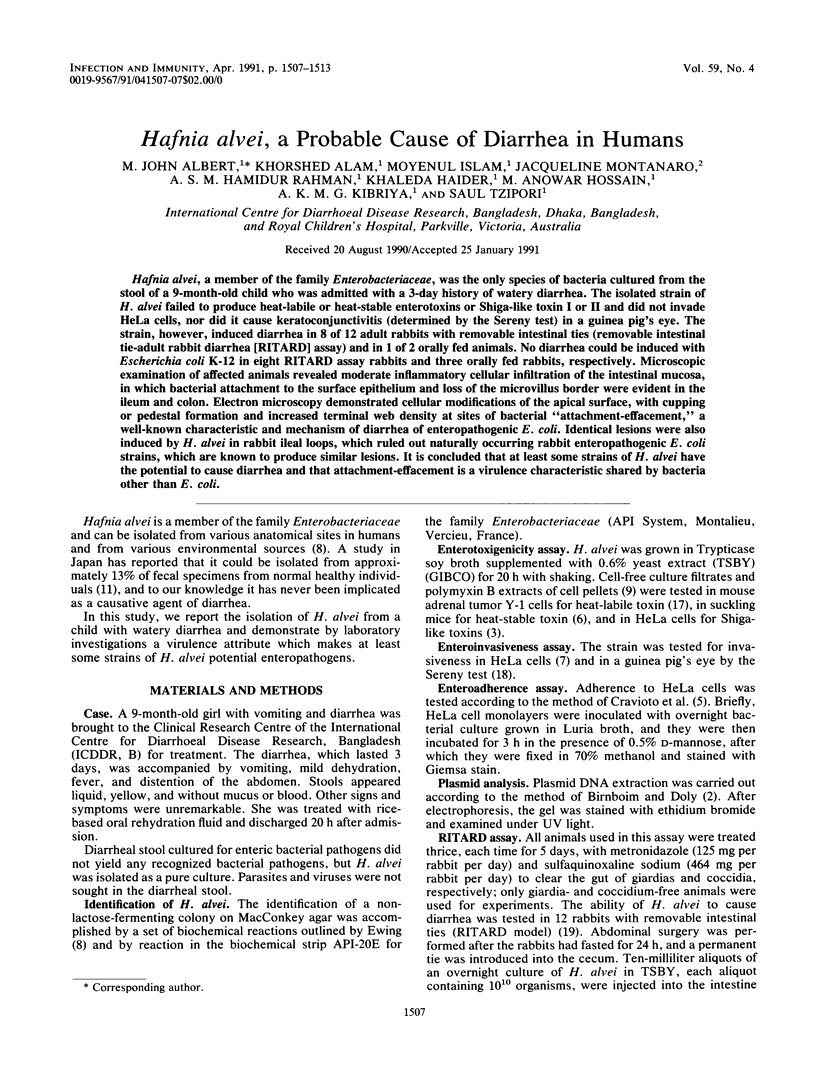
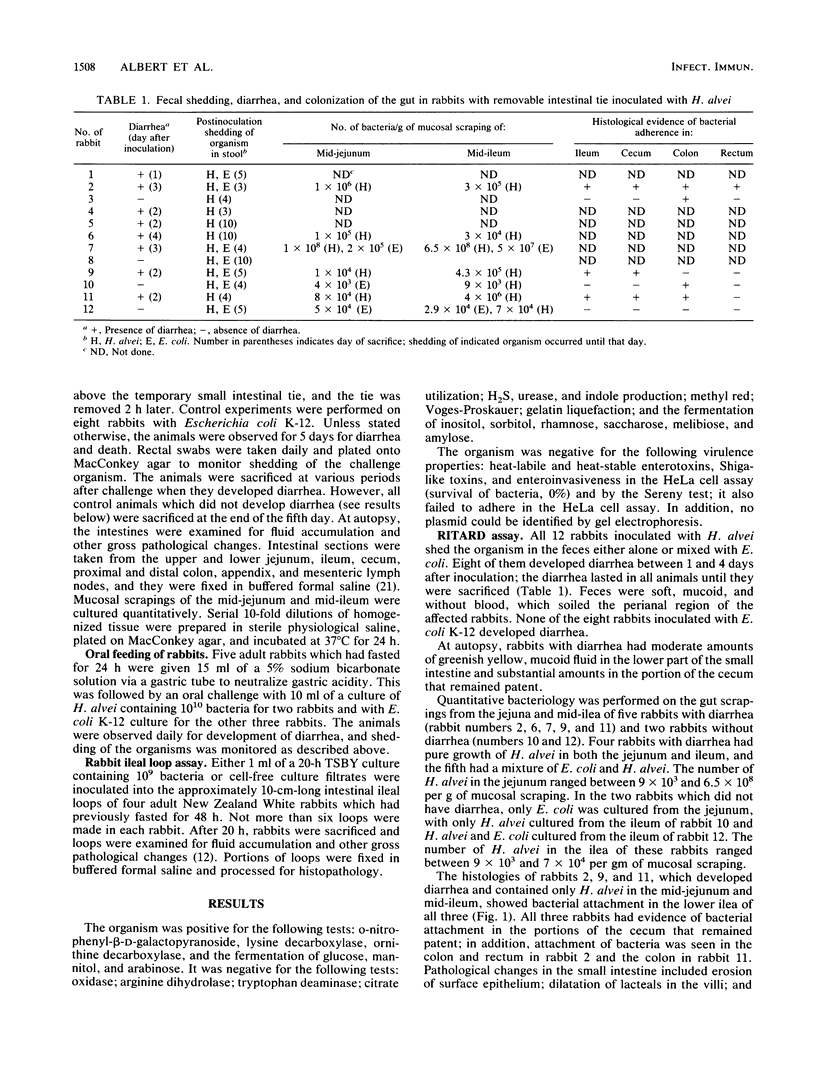
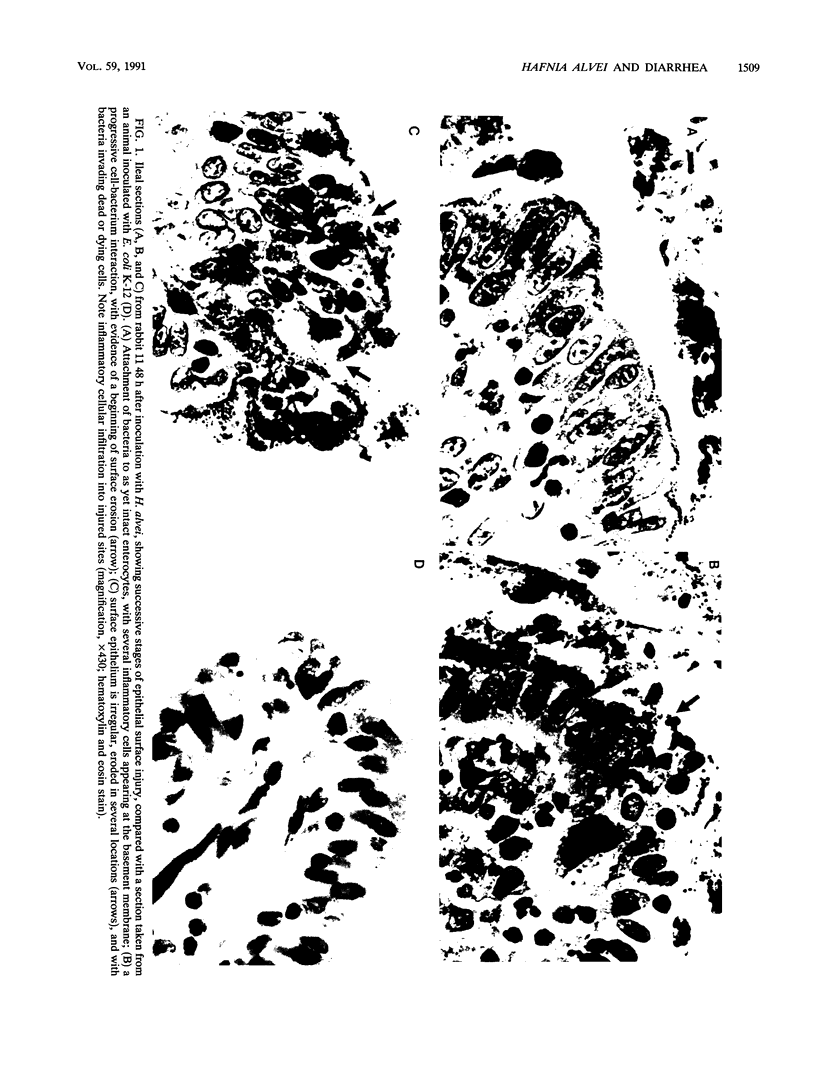
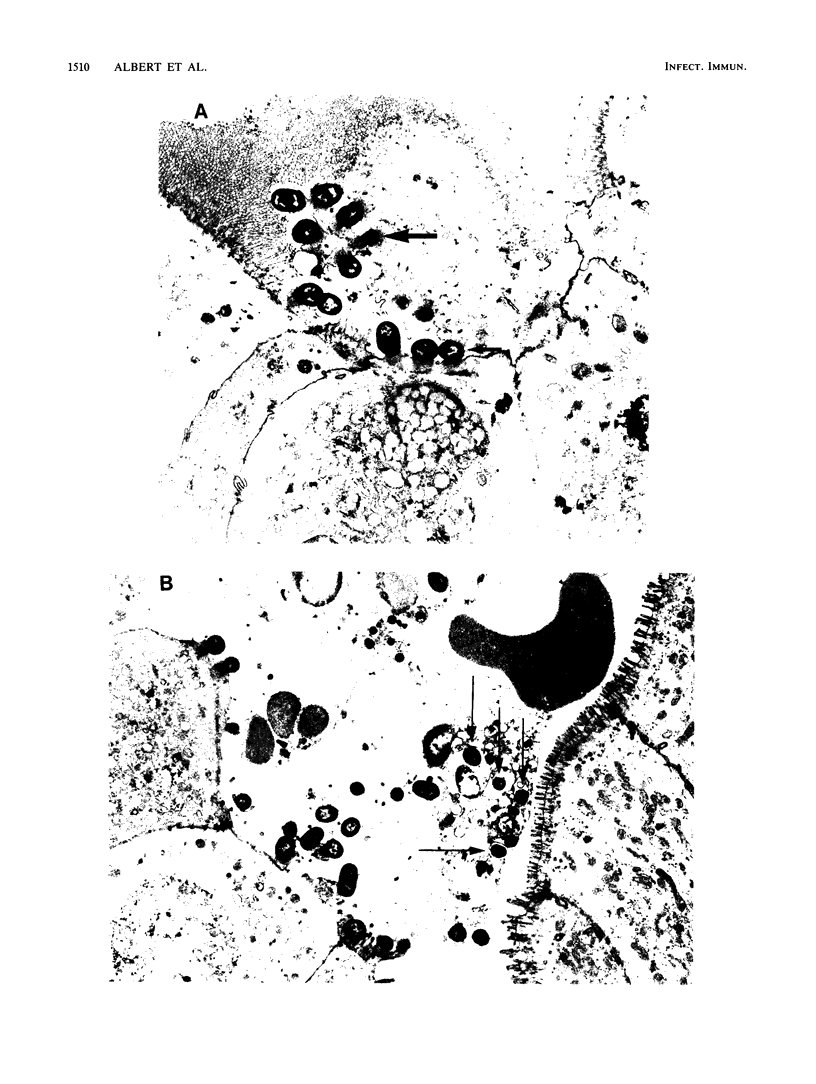
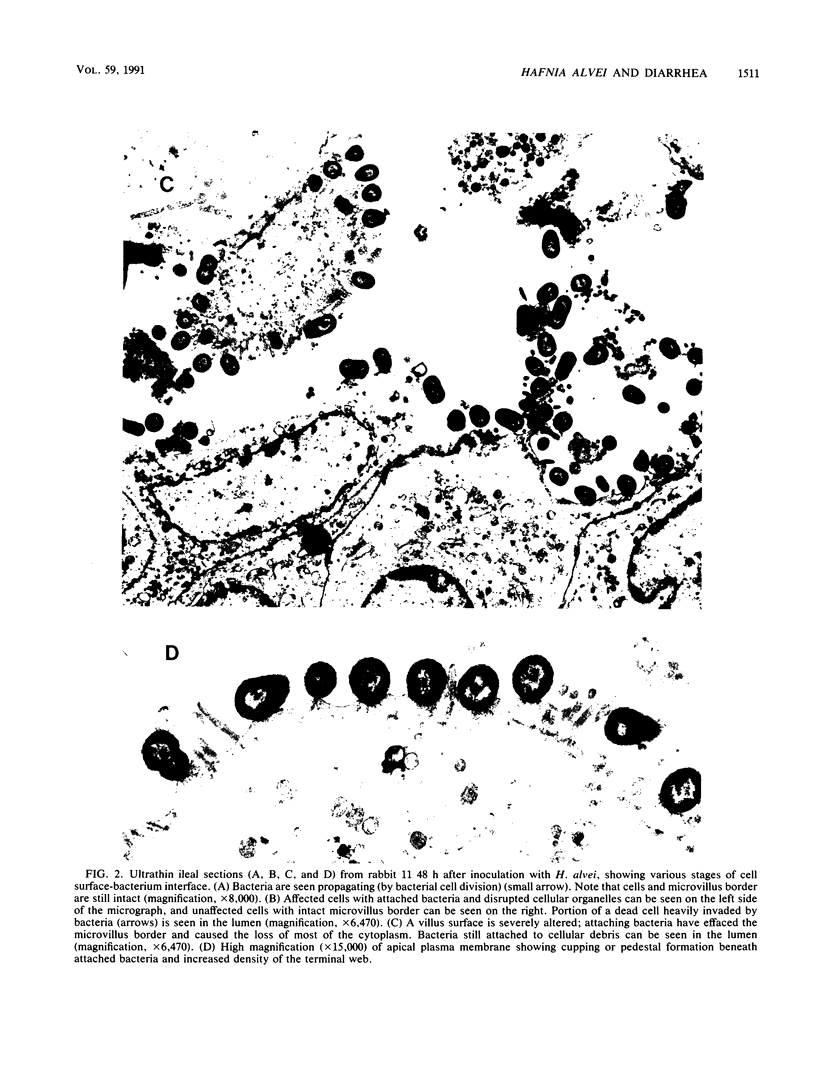
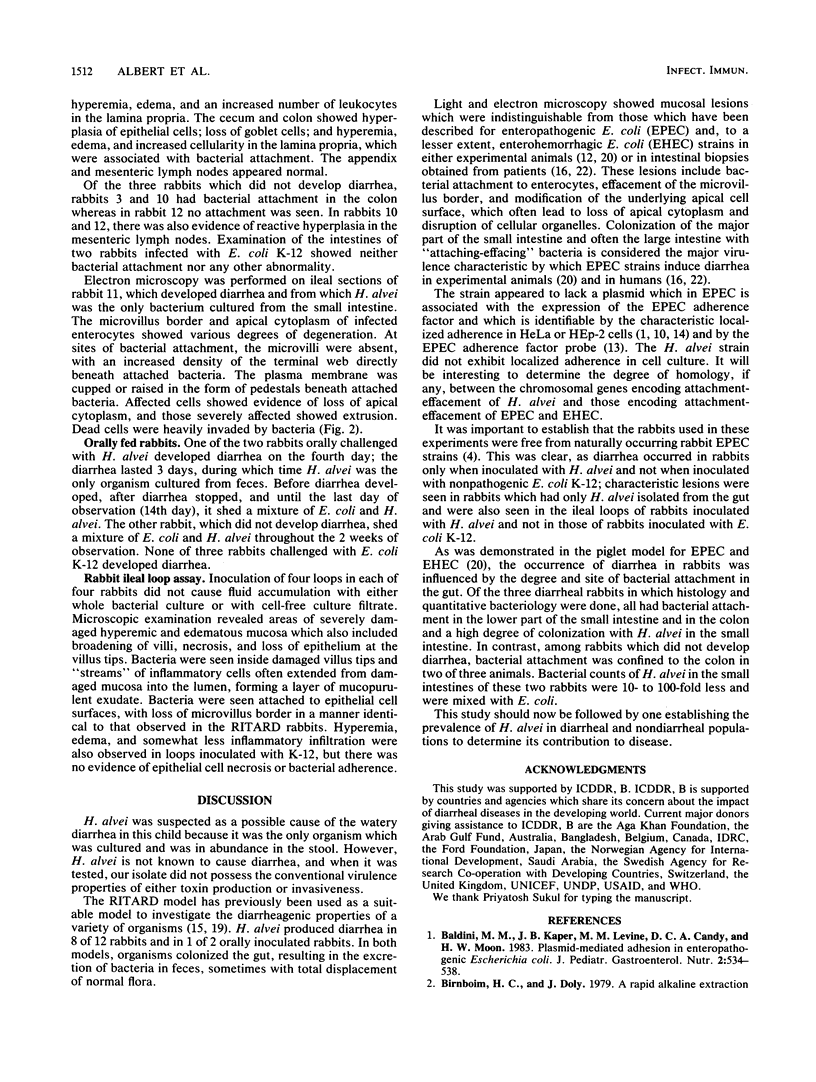
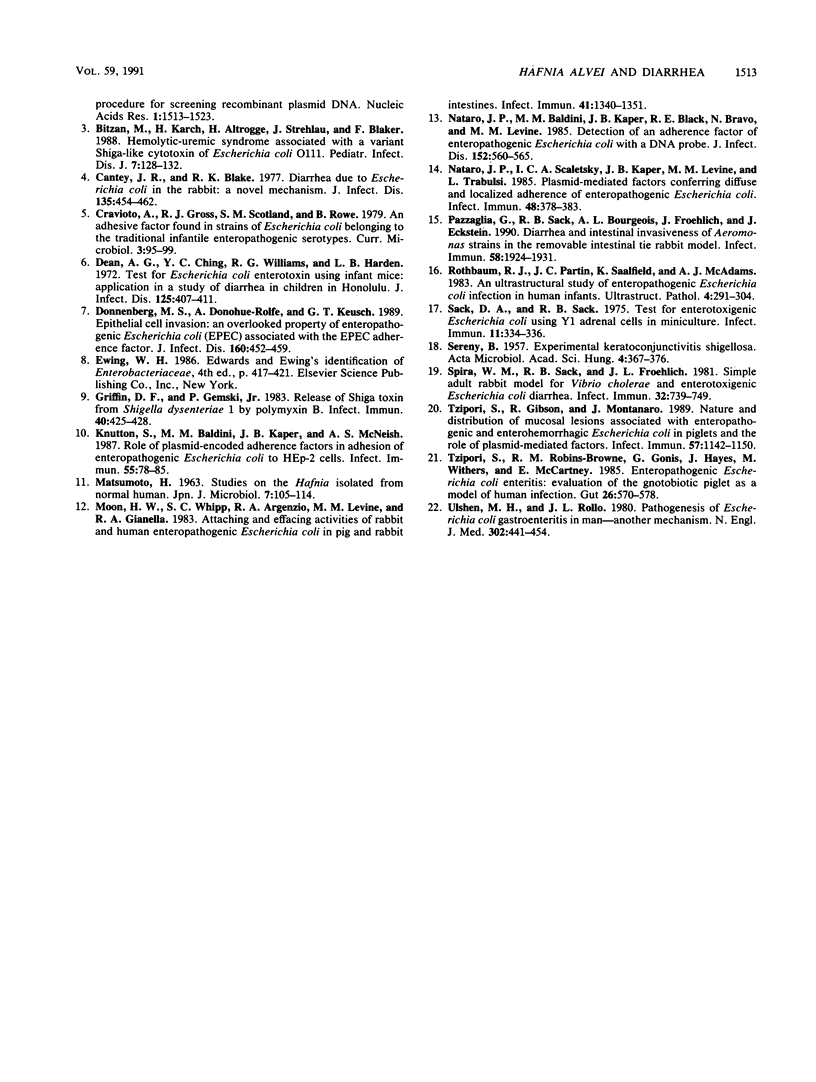
Images in this article
Selected References
These references are in PubMed. This may not be the complete list of references from this article.
- Baldini M. M., Kaper J. B., Levine M. M., Candy D. C., Moon H. W. Plasmid-mediated adhesion in enteropathogenic Escherichia coli. J Pediatr Gastroenterol Nutr. 1983;2(3):534–538. doi: 10.1097/00005176-198302030-00023. [DOI] [PubMed] [Google Scholar]
- Birnboim H. C., Doly J. A rapid alkaline extraction procedure for screening recombinant plasmid DNA. Nucleic Acids Res. 1979 Nov 24;7(6):1513–1523. doi: 10.1093/nar/7.6.1513. [DOI] [PMC free article] [PubMed] [Google Scholar]
- Bitzan M., Karch H., Altrogge H., Strehlau J., Bläker F. Hemolytic-uremic syndrome associated with a variant Shiga-like cytotoxin of Escherichia coli O111. Pediatr Infect Dis J. 1988 Feb;7(2):128–132. doi: 10.1097/00006454-198802000-00013. [DOI] [PubMed] [Google Scholar]
- Cantey J. R., Blake R. K. Diarrhea due to Escherichia coli in the rabbit: a novel mechanism. J Infect Dis. 1977 Mar;135(3):454–462. doi: 10.1093/infdis/135.3.454. [DOI] [PubMed] [Google Scholar]
- Dean A. G., Ching Y. C., Williams R. G., Harden L. B. Test for Escherichia coli enterotoxin using infant mice: application in a study of diarrhea in children in Honolulu. J Infect Dis. 1972 Apr;125(4):407–411. doi: 10.1093/infdis/125.4.407. [DOI] [PubMed] [Google Scholar]
- Donnenberg M. S., Donohue-Rolfe A., Keusch G. T. Epithelial cell invasion: an overlooked property of enteropathogenic Escherichia coli (EPEC) associated with the EPEC adherence factor. J Infect Dis. 1989 Sep;160(3):452–459. doi: 10.1093/infdis/160.3.452. [DOI] [PubMed] [Google Scholar]
- Griffin D. E., Gemski P. Release of Shiga toxin from Shigella dysenteriae 1 by polymyxin B. Infect Immun. 1983 Apr;40(1):425–428. doi: 10.1128/iai.40.1.425-428.1983. [DOI] [PMC free article] [PubMed] [Google Scholar]
- Knutton S., Baldini M. M., Kaper J. B., McNeish A. S. Role of plasmid-encoded adherence factors in adhesion of enteropathogenic Escherichia coli to HEp-2 cells. Infect Immun. 1987 Jan;55(1):78–85. doi: 10.1128/iai.55.1.78-85.1987. [DOI] [PMC free article] [PubMed] [Google Scholar]
- MATSUMOTO H. STUDIES ON THE HAFNIA ISOLATED FROM NORMAL HUMAN. Jpn J Microbiol. 1963 Oct;7:105–114. [PubMed] [Google Scholar]
- Moon H. W., Whipp S. C., Argenzio R. A., Levine M. M., Giannella R. A. Attaching and effacing activities of rabbit and human enteropathogenic Escherichia coli in pig and rabbit intestines. Infect Immun. 1983 Sep;41(3):1340–1351. doi: 10.1128/iai.41.3.1340-1351.1983. [DOI] [PMC free article] [PubMed] [Google Scholar]
- Nataro J. P., Baldini M. M., Kaper J. B., Black R. E., Bravo N., Levine M. M. Detection of an adherence factor of enteropathogenic Escherichia coli with a DNA probe. J Infect Dis. 1985 Sep;152(3):560–565. doi: 10.1093/infdis/152.3.560. [DOI] [PubMed] [Google Scholar]
- Nataro J. P., Scaletsky I. C., Kaper J. B., Levine M. M., Trabulsi L. R. Plasmid-mediated factors conferring diffuse and localized adherence of enteropathogenic Escherichia coli. Infect Immun. 1985 May;48(2):378–383. doi: 10.1128/iai.48.2.378-383.1985. [DOI] [PMC free article] [PubMed] [Google Scholar]
- Pazzaglia G., Sack R. B., Bourgeois A. L., Froehlich J., Eckstein J. Diarrhea and intestinal invasiveness of Aeromonas strains in the removable intestinal tie rabbit model. Infect Immun. 1990 Jun;58(6):1924–1931. doi: 10.1128/iai.58.6.1924-1931.1990. [DOI] [PMC free article] [PubMed] [Google Scholar]
- Rothbaum R. J., Partin J. C., Saalfield K., McAdams A. J. An ultrastructural study of enteropathogenic Escherichia coli infection in human infants. Ultrastruct Pathol. 1983 Jun;4(4):291–304. doi: 10.3109/01913128309140582. [DOI] [PubMed] [Google Scholar]
- SERENY B. Experimental keratoconjunctivitis shigellosa. Acta Microbiol Acad Sci Hung. 1957;4(4):367–376. [PubMed] [Google Scholar]
- Sack D. A., Sack R. B. Test for enterotoxigenic Escherichia coli using Y-1 adrenal cells in miniculture. Infect Immun. 1975 Feb;11(2):334–336. doi: 10.1128/iai.11.2.334-336.1975. [DOI] [PMC free article] [PubMed] [Google Scholar]
- Spira W. M., Sack R. B., Froehlich J. L. Simple adult rabbit model for Vibrio cholerae and enterotoxigenic Escherichia coli diarrhea. Infect Immun. 1981 May;32(2):739–747. doi: 10.1128/iai.32.2.739-747.1981. [DOI] [PMC free article] [PubMed] [Google Scholar]
- Tzipori S., Gibson R., Montanaro J. Nature and distribution of mucosal lesions associated with enteropathogenic and enterohemorrhagic Escherichia coli in piglets and the role of plasmid-mediated factors. Infect Immun. 1989 Apr;57(4):1142–1150. doi: 10.1128/iai.57.4.1142-1150.1989. [DOI] [PMC free article] [PubMed] [Google Scholar]
- Tzipori S., Robins-Browne R. M., Gonis G., Hayes J., Withers M., McCartney E. Enteropathogenic Escherichia coli enteritis: evaluation of the gnotobiotic piglet as a model of human infection. Gut. 1985 Jun;26(6):570–578. doi: 10.1136/gut.26.6.570. [DOI] [PMC free article] [PubMed] [Google Scholar]



